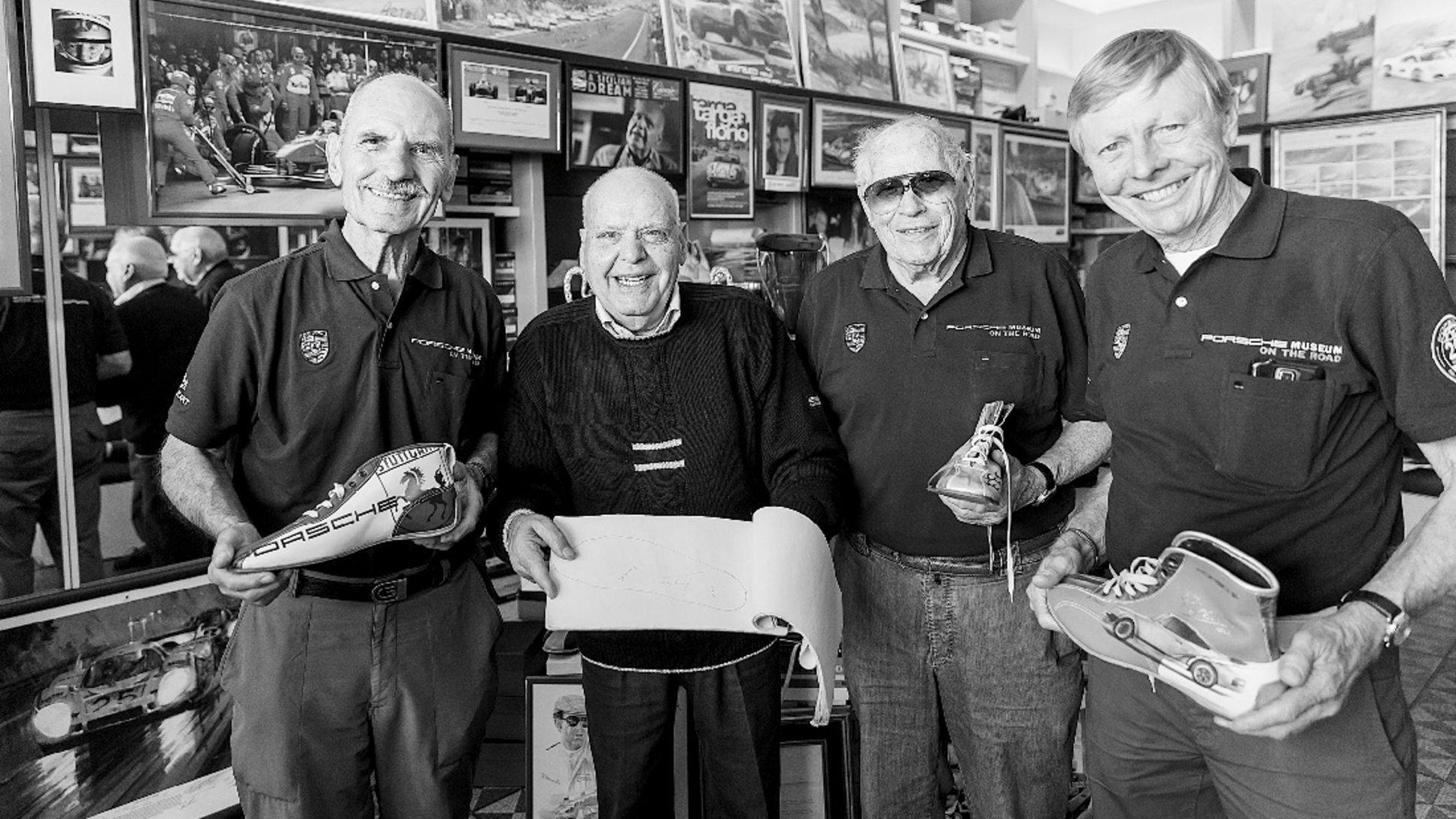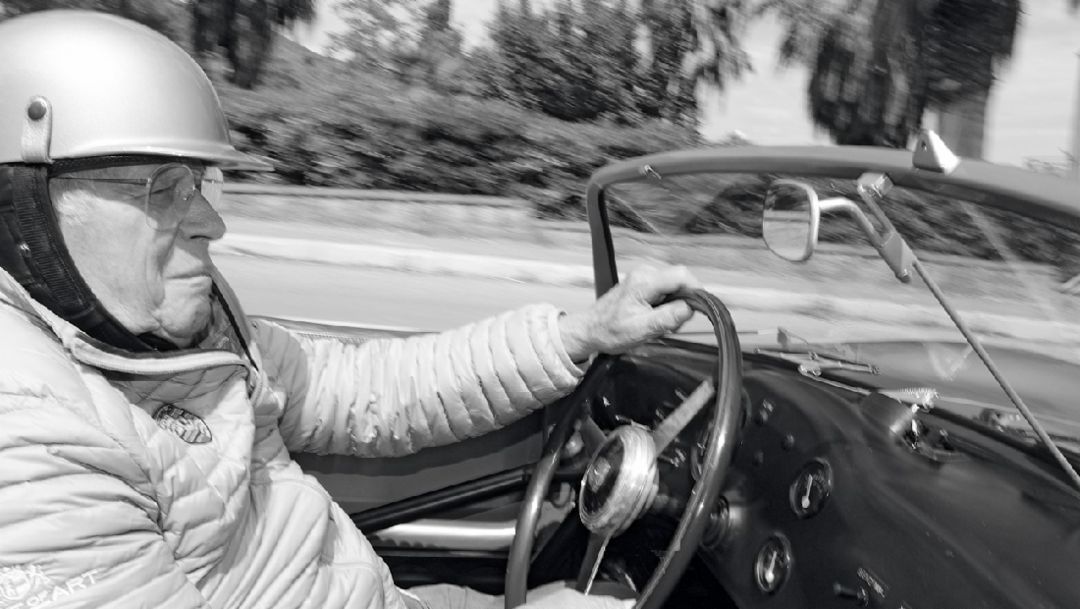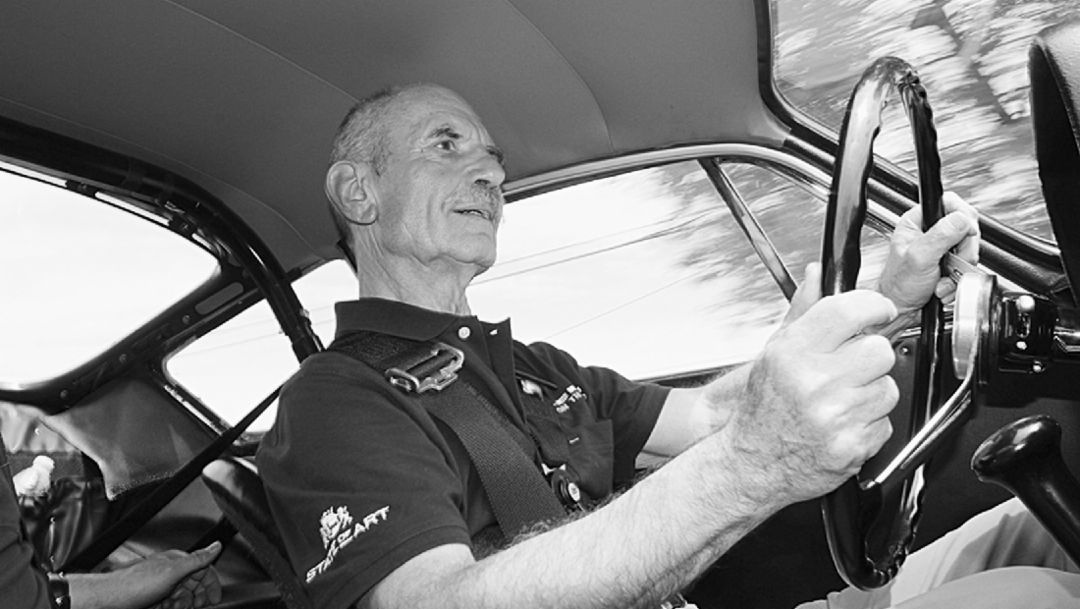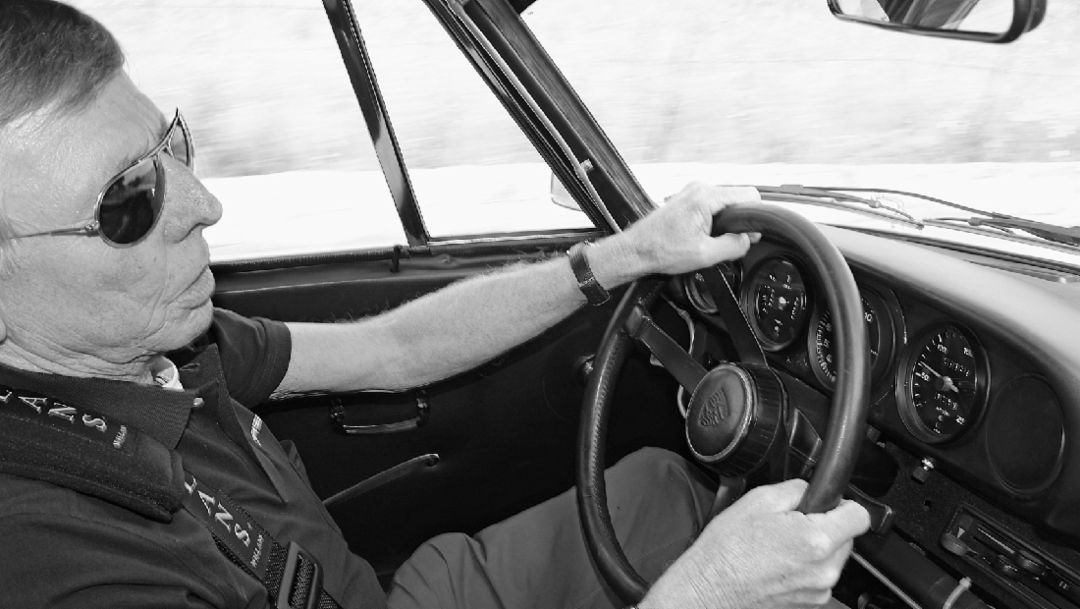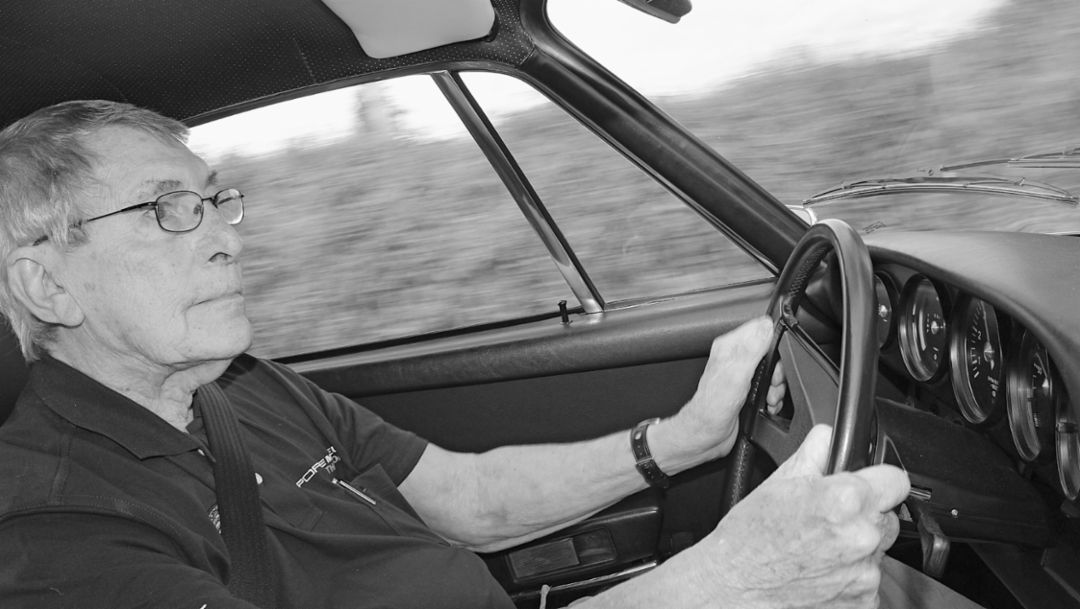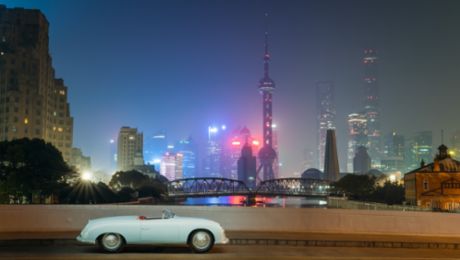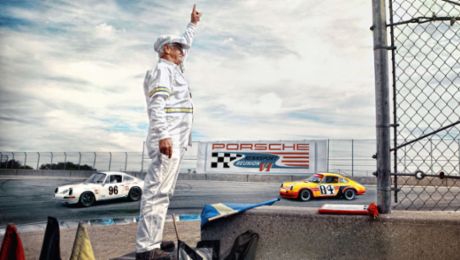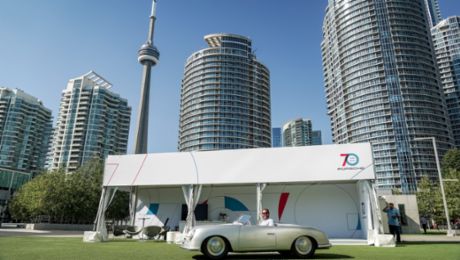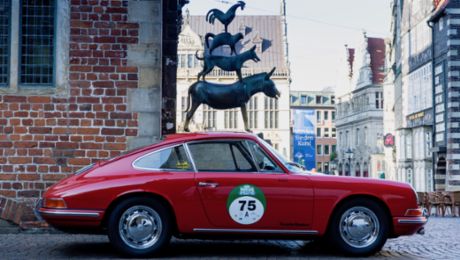Herbert Linge
At 88 years of age, it is not everyone who can still change their shoes standing up. Herbert Linge can. With one hand propped on a bale of straw, he pulls the old loafer from his right foot and slips on a “brand new” old racing shoe. Then comes the left. They are quite special shoes – made by his old friend Francesco “Ciccio” Liberto. The shoemaker from Cefalù knows almost all of the old warriors, and many racing drivers had tailor-made, soft, slim pairs made by the gifted leather worker years ago. Linge had three pairs.
Two of them wore out in endless high-speed battles, but one pair he has preserved. So far he has worn them just one time – for the film shoots for Steve McQueen’s epic “Le Mans”. And now again today: Once more he is driving an original section of the Targa Florio, once the wildest and most dangerous road race in the world. In an old, distinguished car – the Porsche 718 RS 60 Spyder. For special occasions some people like to slip on a suit and tie – Linge prefers his new old shoes.
Four Targa Florio legends back together in Sicily
Everyone is feeling a sense of occasion – not just Linge, but also Gijs van Lennep (76), Günther Steckkönig (80) and Vic Elford (81). The team at the Porsche Museum have managed to bring these four Targa Florio legends back together in Sicily once more for the 110th anniversary of the “Targa” and the 60th anniversary of the first Porsche Targa victory (Umberto Maglioli in the 550 A Spyder). An ideal opportunity to reunite them with some old racing cars and let them again breathe in the scent of leaded petrol, olive trees and delicious pizzas. And also to step on the gas – on the stretch between the buildings still standing at the start and finish line near Cefalù and the first of the larger locations on the route, Cerda.
At the time, Linge never actually drove the 718 RS 60 Spyder, but he gets to grips with the precious racing car at once. The basis of the Spyder is the 718 RSK. Due to a new technical regulation, the cockpit had to be changed, which was only possible with an extended and widened tubular steel frame. The added weight was balanced out by means of lighter wheels and magnesium brake drums. The vehicle was launched in 1960 in the World Sportscar Championship; at the “Targa” of that year two 718 RS Spyders came in first and third. But the vehicle was truly in its element in the mountains: Heini Walter from Switzerland won the European Hill Climb Championship in it in 1960 and 1961.
Chatting with Linge while he is driving the Spyder only proves to be difficult if you are unfamiliar with the Swabian dialect of southwestern Germany. “The first time I was here was in 1959,” he recalls, “and the cars proved to be extremely reliable from the outset.” In ten races, Linge was never able to get a win and came in second “only” twice; “but I always came in!” The racing director at the time, Huschke von Hanstein, always wanted to go to the “Targa”, to show what the little cars from Stuttgart had in them: And this was not just any old race... But nor was Linge just any old Porsche employee. Born in Weissach, as an apprentice mechanic he became Porsche employee number 13, as his company ID still shows today. He always remained loyal to the company, occupying various positions, founding the ONS safety crew and becoming its technical director. Up until he 1993, he still managed the Carrera Cup.
From 1954 to 1970, he took up the racing wheel himself. In 1954, he drove the Porsche 550 Spyder in the Mille Miglia, winning his class and coming sixth overall, won the Liège-Rome-Liège Rally in a 356 SL, came second in the Tour de France in the 550 Spyder and took fourth place in the Carrera Panamericana in the same vehicle. 1961 saw him racing in the Targa Florio for the first time in the 356 B Carrera GTL Abarth. In 1963, he came third overall there (and first in his class) in the famous “Dreikantschaber” (“triangular scraper”) 356 B Carrera GT. In 1964, he came in fourth overall in Le Mans in the Porsche 904, and repeated the achievement in 1965. Overall, Linge secured a phenomenal 90 class victories for Porsche.
Günther Steckkönig
If Linge has remained a humble man, Günther Steckkönig is even more so. It is with an almost Prussian upright bearing that the Swabian with the striking walrus moustache takes his seat behind the wheel of the Porsche 356 B 1600 Carrera GTL Abarth; with lean arms he powers the last co-production between Abarth and Porsche up the mountain. The vertical shaft engine whines for speed, and Steckkönig provides it. Conversation is only possible coming up to bends or when he has to slow down because another participant has been damaged. The sound of the Porsche is infernal – beautifully infernal, but infernal nonetheless. Steckkönig is having a wonderful time – back in the day, he was never quite sure whether he was an engineer who raced or a racing driver who did engineering. For him, Sicily is a great world where he first raced in 1971.
His life at Porsche began in 1953. Originally from the town of Degerloch, he was at that time one of the first eight apprentices with the sportscar manufacturer; afterwards, he attended the technical school in Stuttgart. His occupation was what we call a “test driver”. For 30 years in total, he worked in road tests for Porsche, introduced Formula Vee together with Huschke von Hanstein and drove almost all the racing cars that Porsche set on wheels at the time. In 1968, he received his first works assignment – and in return delivered second place in the Marathon de la Rout on the Nürburgring in the Porsche 911 R. In 1970, he became the overall winner among the GT sportscars at the Österreich-Ring in the 914/6. In 1976, he came in a sensational seventh place in Le Mans in the 908/03. He competed in the Targa Florio three times: in 1971 in the Porsche 914/6 GT, in 1972 in a 911 S (class winner and sixth overall despite an accident) and in 1973 in a Carrera RSR. “The spectators were always particularly friendly here,” he explains, when the Fuhrmann engine lets him; “extremely enthusiastic even – you didn’t get that anywhere else.”
Between engines and transmissions
But in 1973 he was lucky to be able to start at all. He travelled in the spare parts plane between engines and transmissions – and as soon as he arrived he was told that his co-pilot had crashed the competition vehicle. “But I categorically wanted to drive,” he recalls. “The sports boss Norbert Singer suggested the “Muletto” – the training car – for the race. So I got in the training RSR and familiarised myself with it during the race...” And still came in sixth overall. But it was after the car had done its work and he was taking it back to Stuttgart that Steckkönig really became a legend. Due to an electrical fault and a problematic restart, he did the entire stretch from mainland Italy to Weissach without turning off the engine once...
His encounter with the 356 B 1600 Carrera GTL Abarth in 2016 is, however, a first for Steckkönig. The car is the result of the cooperation between Porsche and the Italian tuner Abarth that began with the Cisitalia Type 360. At the start of the 60s, Porsche wanted to get in on the GT sport scene, and needed a lightweight version of the 356. Carlo Abarth sent the order for 20 lightweight coupés to Zagato in Milan. The specialists did a great job: The body was made a full 140 kilogrammes lighter than the normal Porsche 356 B. In 1960, with Hans Hermann and Joakim Bonnier behind the wheel, the car won, among others, the Targa Florio with a 1.6-litre engine, and in 1961 it started with a 2-litre Carrera drive.
Gijs van Lennep
The taste of victory is something with which Gijs van Lennep is also familiar. Trained as a forwarding merchant and hailing from Bloemendaal in the Netherlands, his motorsport career began in 1965 in the Formula Vee. In 1966, he was class winner in the 1000 km race in the Porsche 906 short tail, and in 1970 he secured the Porsche Cup. One year later, he sped to victory in Le Mans with Dr Helmut Marko in the Porsche 917 KH, and in 1972 this man of many talents won the European Championship in the Formula 5000. In 1973, he was the winner of the Targa Florio in the Porsche 911 Carrera RSR and came fourth in Le Mans. He repeated his Le Mans win in 1976, again in the Porsche 936. It is little wonder that he is excited when Porsche puts him in the sister model of his RSR for the Targa revival – unfortunately, it could not be the original car in which Herbert Müller once triumphed as this is in private ownership. All the same, the museum’s car came third with Leo Kinnunen and Claude Haldi.
Porsche developed the RSR as a GT racer on the basis of the Carrera RS 2.7. With 300 hp and a weight of just 900 kilogrammes, the Porsche won the 24 Hours of Daytona in early 1973. After that, the vehicle took part in the prototype class, which allows more technical freedom. Here, it gained another 10 hp, but also 40 kilogrammes in weight. A total of 55 RSRs were produced. One of them is now being being vigorously and skilfully put through its paces by van Lennep. He curves round what are at times dramatic tectonic fault lines on the tarmac with agility, without slowing down. How was it possible back then for a GT car to overcome the competition? “Quite simple,” he says, “because the others made mistakes. Merzario had an engine failure; Ickx didn’t know the route well enough and crashed. After three laps, we were already in the lead and just carried on driving with precision. In a road race like the Targa Florio if you make just one little mistake, that can be it...”
Vic Elford
If van Lennep is constantly besieged by fans, with “Quick Vic” it is practically a miracle that he ever gets to drive at all. If the Sicilians have a hero, it is Vic Elford. Autograph here, autograph there, selfies in demand on all sides. Not quite so quick on his feet any more, the Englishman by birth and American by choice comes alive behind the wheel of a Porsche. The 911 2.7 RS Touring that Elford drives down the hill to his first training session is not really his thing (the seat cannot be adjusted far enough, “and the front axle is not balanced”) – later, he would rather drive the Abarth-Porsche.
But whatever the car – the man with the photographic memory can drive them all. No wonder, since he has raced almost everything with four wheels. After a technical education, he became a works driver with Porsche in 1966 and first drove in rallies. Still in 1966, he achieved third place in the Tour de Corse in a Porsche 911, and one year later he won the Stuttgart–Lyon–Charbonnières Rally. His career soared upwards thanks to victories in the European Rally Championship in 1961 in a Porsche 911 T, among others. In the same year, he won the Targa Florio in a Porsche 907 KH, the 24 Hours of Daytona in the long-tail 907 and also brought back the trophy in the 1000 km of the Nürburgring in the 908 short tail. He similarly bagged the Monte Carlo Rally in a Porsche 911 T. In 1969, he took another second place at the Targa Florio in the Porsche 911 T, after which he switched to Formula 1.
48 years ago: his greatest triumph
“But the Targa Florio was always my favourite race,” says Elford – between 1967 and 1972, he drove it six times in succession. He won it only in 1968, but in each of the subsequent races drove the fastest lap. Hence “Quick Vic”. Who still today sings the praises of the helpful Sicilians who enabled him to achieve his greatest triumph 48 years ago. “Just after the start, I lost a wheel here between Cefalù and Cerda. The spectators came jumping down from the wall and lifted up my light car so that I could fit the spare wheel. Just imagine it: A Brit in a German car...” That did not bother the spectators a few bends further down the road either: “That’s where I lost the next wheel. Again the people lifted up the car, and because I didn’t have another spare wheel, one fan unscrewed the wheel from his own private car and lent it to me.”
Thanks to this trick, Vic was back in the race and won it. But maybe it was also down to his shoes. Because they, of course, come from the shoemaker Ciccio. To this day, he still has the original sketches of Elford’s feet that he used to fashion the driving shoes. Unmistakable, because following a childhood accident Elford’s left foot is missing the little toe. Today he drives in brown loafers. Looks like the “American way of life” has left its mark on him after all...
Info
Text first published in the magazine "Porsche Klassik 10".
Text by Roland Löwisch // Photos by Markus Leser, Roland Löwisch, Porsche
Copyright: The image and sound published here is copyright by Dr. Ing. h.c. F. Porsche AG, Germany or other individuals. It is not to be reproduced wholly or in part without prior written permission of Dr. Ing. h.c. F. Porsche AG. Please contact newsroom@porsche.com for further information.
